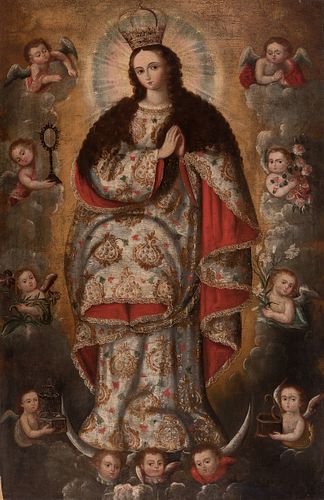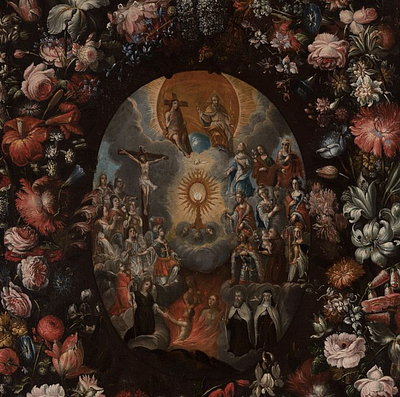Cuzco School, late seventeenth century.DIEGO QUISPE TITO (Peru, 1611 - 1681), attributed. "Virgin with angels. Oil on canvas.
Lot 137
About Seller
Setdart Auction House
Carrer Aragó 346
Barcelona
Spain
Setdart Subastas was born in 2004 and is currently the first online art auction in Spain with solidity, prestige and reliability guaranteed by our more than 60,000 users. Setdart has a young, dynamic and enterprising team ready to successfully manage the purchase and sale of art works through custom...Read more
Categories
Estimate:
EUR€20,000 - EUR€25,000
$21,505.38 - $26,881.72
Absentee vs Live bid
Two ways to bid:
- Leave a max absentee bid and the platform will bid on your behalf up to your maximum bid during the live auction.
- Bid live during the auction and your bids will be submitted real-time to the auctioneer.
Bid Increments
| Price | Bid Increment |
|---|---|
| EUR€0 | EUR€10 |
| EUR€200 | EUR€25 |
| EUR€500 | EUR€50 |
| EUR€1,000 | EUR€100 |
| EUR€3,000 | EUR€200 |
| EUR€5,000 | EUR€500 |
| EUR€10,000 | EUR€1,000 |
| EUR€20,000 | EUR€2,000 |
| EUR€50,000 | EUR€5,000 |
About Auction
By Setdart Auction House
Jul 14, 2021
Set Reminder
2021-07-14 06:30:00
2021-07-14 06:30:00
America/New_York
Bidsquare
Bidsquare : OLD MASTERS
https://www.bidsquare.com/auctions/setdart-auction-house/old-masters-7202
Setdart Auction House sofia@setdart.com
Setdart Auction House sofia@setdart.com
- Lot Description
Cuzco School, late seventeenth century.DIEGO QUISPE TITO (Peru, 1611 - 1681), attributed. "Virgin with angels. Oil on canvas. Size: 168 x 109 cm. The excellent quality of this painting, especially in the emulation of the brocade and the trimming of the Virgin's mantle, as well as in the cascading fall of the silky hair of amber reflections, the hand of Diego Quispe Tito, one of the most outstanding masters of the Peruvian school of the XVII century, can be appreciated. The sumptuousness of tunics and mantles, in Quispe's Marian representations, is expressed, for example, in the Virgin of Carmen preserved in the Brooklyn Museum, a work that we can relate to the one we are dealing with. In this case, the Virgin appears surrounded by cherubim and seraphim emerging from the golden sky, among cottony clouds. They carry offerings in the form of flowers and monstrances. Following the Spanish baroque model in the representation of the Immaculate Conception, the Virgin rests on a crescent moon. But, in spite of presenting echoes of the Murillo language, the painting in question is developed in a typically autochthonous language, cuzqueño, which Diego Quispe contributed to define. Diego Quispe Tito was a Peruvian painter of Andean origin. He is considered one of the most outstanding members of the Cuzco School. The documentary testimonies regarding his life are scarce, however, it can be said that he began his pictorial work around 1627, date of which dates his first canvas and probably belonged to the indigenous nobility. He established himself as an artist of great prestige in the city of Cusco from the 1660s, when he intensified his production for the temple of San Sebastian. It is from the virtuosity he demonstrates in the painting cycles he produces for this temple that he wins the favor of his most important patrons in Cuzco and Upper Peru, where he regularly sent paintings. In a painting he sent to Potosí in 1667 he signed "Quispi Tito inga inbentó del año D-1667, edad 56", a way of highlighting the creative and cultured aspect of his work. He was a follower of Gregorio Gamarra, who in turn was a disciple of father Bernardo Bitti. His painting had two stages. In the first, his painting was characterized by certain traces of Mannerism, while in the second, the influence of Flemish engravings can be seen in his painting. However, he is a painter who is somewhat outside the prevailing style in the city of Cuzco and who ends up developing and imposing a new style to the painting of the region. He implants the use of large landscapes full of flowers and animals that later become characteristic of Cuzco painting.
- Shipping Info
-
In-house shipping available. Please inquire at admin@setdart.com.
-
- Buyer's Premium



 EUR
EUR CAD
CAD AUD
AUD GBP
GBP MXN
MXN HKD
HKD CNY
CNY MYR
MYR SEK
SEK SGD
SGD CHF
CHF THB
THB

















